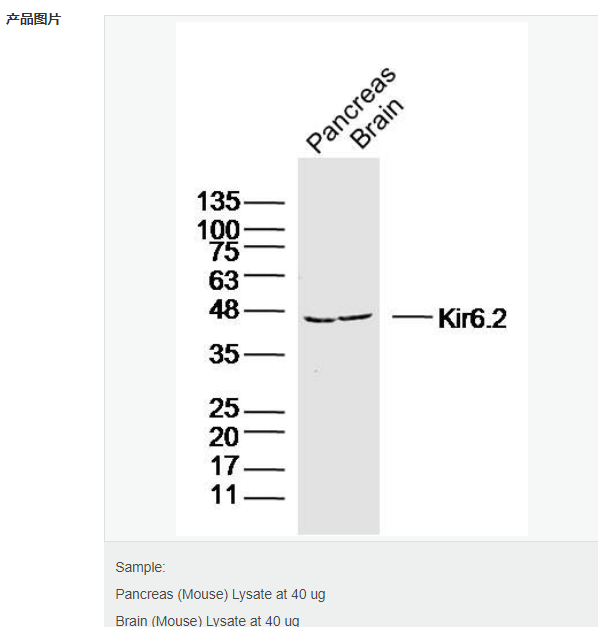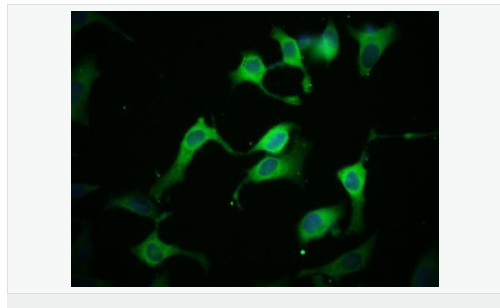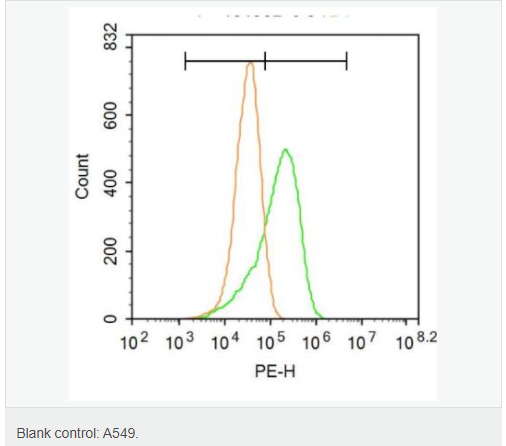
货号
产品规格
售价
备注
BN41821R-50ul
50ul
¥1486.00
交叉反应:Human,Mouse(predicted:Rat,Dog,Cow,Rabbit) 推荐应用:WB,IF,Flow-Cyt,ELISA
BN41821R-100ul
100ul
¥2360.00
交叉反应:Human,Mouse(predicted:Rat,Dog,Cow,Rabbit) 推荐应用:WB,IF,Flow-Cyt,ELISA
BN41821R-200ul
200ul
¥3490.00
交叉反应:Human,Mouse(predicted:Rat,Dog,Cow,Rabbit) 推荐应用:WB,IF,Flow-Cyt,ELISA
| 英文名称 | Kir6.2 |
| 中文名称 | ATP敏感性钾通道亚基kir6.2抗体 |
| 别 名 | ATP sensitive inward rectifier potassium channel 11; Beta cell inward rectifier subunit; mBIR; BIR; HHF 2; HHF2; IKATP; Inward rectifier K(+) channel Inwardly rectifying potassium channel KIR6.2; IRK 11; IRK11; KCNJ11; Kir 6.2; MGC133230; PHHI; Potassium channel, inwardly rectifying subfamily J member 11; Potassium inwardly rectifying channel J11; TNDM 3; TNDM3; IRK11_HUMAN. |
| 研究领域 | 肿瘤 心血管 细胞生物 神经生物学 信号转导 转录调节因子 通道蛋白 |
| 抗体来源 | Rabbit |
| 克隆类型 | Polyclonal |
| 交叉反应 | Human, Mouse, (predicted: Rat, Dog, Cow, Rabbit, ) |
| 产品应用 | WB=1:500-2000 ELISA=1:5000-10000 Flow-Cyt=3ug/test ICC=1:100-500 IF=1:100-500 not yet tested in other applications. optimal dilutions/concentrations should be determined by the end user. |
| 分 子 量 | 43kDa |
| 细胞定位 | 细胞膜 |
| 性 状 | Liquid |
| 浓 度 | 1mg/ml |
| 免 疫 原 | KLH conjugated synthetic peptide derived from human Kir62:301-390/390 |
| 亚 型 | IgG |
| 纯化方法 | affinity purified by Protein A |
| 储 存 液 | 0.01M TBS(pH7.4) with 1% BSA, 0.03% Proclin300 and 50% Glycerol. |
| 保存条件 | Shipped at 4℃. Store at -20 °C for one year. Avoid repeated freeze/thaw cycles. |
| PubMed | PubMed |
| 产品介绍 | Potassium channels are present in most mammalian cells, where they participate in a wide range of physiologic responses. The protein encoded by this gene is an integral membrane protein and inward-rectifier type potassium channel. The encoded protein, which has a greater tendency to allow potassium to flow into a cell rather than out of a cell, is controlled by G-proteins and is found associated with the sulfonylurea receptor SUR. Mutations in this gene are a cause of familial persistent hyperinsulinemic hypoglycemia of infancy (PHHI), an autosomal recessive disorder characterized by unregulated insulin secretion. Defects in this gene may also contribute to autosomal dominant non-insulin-dependent diabetes mellitus type II (NIDDM), transient neonatal diabetes mellitus type 3 (TNDM3), and permanent neonatal diabetes mellitus (PNDM). Multiple alternatively spliced transcript variants that encode different protein isoforms have been described for this gene. [provided by RefSeq] Function: This receptor is controlled by G proteins. Inward rectifier potassium channels are characterized by a greater tendency to allow potassium to flow into the cell rather than out of it. Their voltage dependence is regulated by the concentration of extracellular potassium; as external potassium is raised, the voltage range of the channel opening shifts to more positive voltages. The inward rectification is mainly due to the blockage of outward current by internal magnesium. Can be blocked by extracellular barium (By similarity). Subunit of ATP-sensitive potassium channels (KATP). Can form cardiac and smooth muscle-type KATP channels with ABCC9. KCNJ11 forms the channel pore while ABCC9 is required for activation and regulation. Subunit: Interacts with ABCC8/SUR. Interacts with ABCC9/SUR2. Subcellular Location: Cell Membrane; Multi-pass membrane protein Post-translational modifications: Phosphorylation by MAPK1 results in changes in channel gating that destabilize the closed states and reduce the ATP sensitivity. DISEASE: Familial hyperinsulinemic hypoglycemia 2 (HHF2) [MIM:601820]: Most common cause of persistent hypoglycemia in infancy. Unless early and aggressive intervention is undertaken, brain damage from recurrent episodes of hypoglycemia may occur. Note=The disease is caused by mutations affecting the gene represented in this entry. Diabetes mellitus, permanent neonatal (PNDM) [MIM:606176]: A rare form of diabetes distinct from childhood-onset autoimmune diabetes mellitus type 1. It is characterized by insulin-requiring hyperglycemia that is diagnosed within the first months of life. Permanent neonatal diabetes requires lifelong therapy. Note=The disease is caused by mutations affecting the gene represented in this entry. Transient neonatal diabetes mellitus 3 (TNDM3) [MIM:610582]: Neonatal diabetes mellitus, defined as insulin-requiring hyperglycemia within the first month of life, is a rare entity. In about half of the neonates, diabetes is transient and resolves at a median age of 3 months, whereas the rest have a permanent form of diabetes. In a significant number of patients with transient neonatal diabetes mellitus, diabetes type 2 appears later in life. The onset and severity of TNDM3 is variable with childhood-onset diabetes, gestational diabetes or adult-onset diabetes described. Note=The disease is caused by mutations affecting the gene represented in this entry. [DISEASE] Note=Defects in KCNJ11 may contribute to non-insulin-dependent diabetes mellitus (NIDDM), also known as diabetes mellitus type 2. Similarity: Belongs to the inward rectifier-type potassium channel (TC 1.A.2.1) family. KCNJ11 subfamily. SWISS: Q14654 Gene ID: 3767 Database links: Entrez Gene: 3767 Human Entrez Gene: 16514 Mouse Omim: 600937 Human SwissProt: Q14654 Human SwissProt: Q61743 Mouse Unigene: 248141 Human Unigene: 333863 Mouse Important Note: This product as supplied is intended for research use only, not for use in human, therapeutic or diagnostic applications. |


